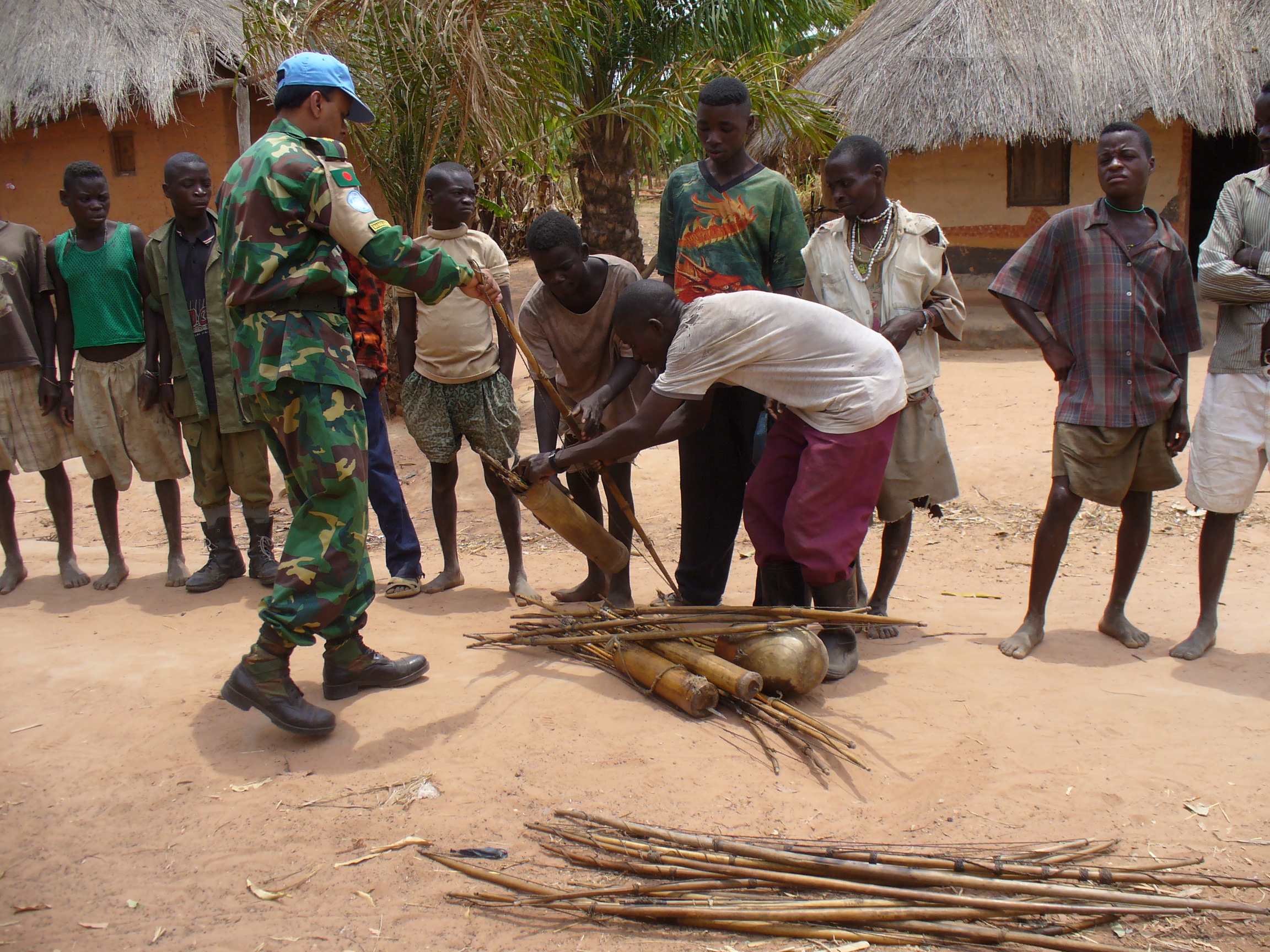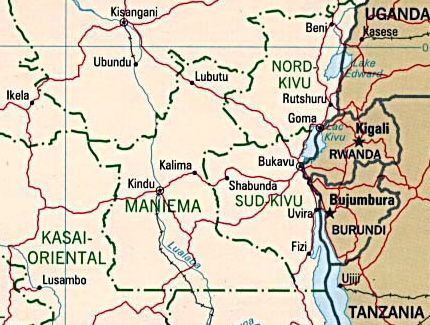|
Pweto Territory
Pweto Territory is a territory in the Haut-Katanga Province of the Democratic Republic of the Congo (DRC). The headquarters are in the town of Pweto. Geography Pweto is part of Haut-Katanga Province. It lies to the west and north of Lake Mweru on the border with Zambia. The Luvua River, a headstream of the Congo River, leaves the lake just west of the town of Pwetu to flow north its confluence with the Lualaba River opposite the town of Ankoro. Other rivers flowing through the territory include the Lubule River, the Lumekele River and the Kilulishi River. The territory is subdivided into the following chiefdoms and sectors: Kiona-Nzini Chiefdom, Moero Sector, Mwenge Sector and Pweto Chiefdom Economy The territory is agriculturally productive and the lake is rich in fish. There is no formal industry apart from the Dikulushi Mine near Kilwa, the capital of Moero Sector, operated by Anvil Mining, an Australian company. There is informal mining in other areas, including cas ... [...More Info...] [...Related Items...] OR: [Wikipedia] [Google] [Baidu] |
Dubie
Dubie (also spelled Dubié) is a Town in Pweto Territory, Pweto territory, Haut-Katanga Province, Haut-Katanga province, Democratic Republic of the Congo. The town suffered great damage during the Second Congo War, which technically ended in 2003. Following the war, local Mai Mai militia continued to operate in the area, living off the people. Army operations against the Mai Mai began in 2005. Many of the local people were displaced to Dubie. Almost all the internally displaced people (IDPs) were living in camps, since they have a different ethnicity from the residents of the village. A March 2006 report said that there were high mortality rates among IDPs at Dubié, increasing levels of malnutrition and insecurity. There were three camps of internally displaced persons, who began arriving in the area in November 2005 and now numbered about 16,000. The army had brought these people to the camps, and was forcing them to labor in the fields to produce food for the army. Médecins ... [...More Info...] [...Related Items...] OR: [Wikipedia] [Google] [Baidu] |
Mwenge Sector
Mwenge is a county of the Kyenjojo district in Uganda }), is a landlocked country in East Africa East Africa, Eastern Africa, or East of Africa, is the eastern subregion of the African continent. In the United Nations Statistics Division scheme of geographic regions, 10-11-(16*) territor .... It makes up the western half of the district. It contains twelve sub-counties and four town councils, namely: *Butunduzi *Katooke *Kyarusozi *Kyenjojo Constituencies of Mwenge *Mwenge North *Mwenge Central *Mwenge South Sub-Counties * Butiiti * Bugaki * Bufunjo * Katooke * Kyarusozi * Matiri *Nyabuharwa *Kigaraale *Butunduuzi *Kyembogo *Kihuura *Barahiija References Counties of Kyenjojo District {{Uganda-geo-stub ... [...More Info...] [...Related Items...] OR: [Wikipedia] [Google] [Baidu] |
Kapulo
The Kapulo mine is a cassiterite mine and a planned copper mine in the Democratic Republic of the Congo. It is located near a village of the same name. In 2007 one of the two remaining full FARDC brigades in Katanga was stationed in Pweto Territory. This brigade, the 62nd, was illegally exploiting the Cassiterite mine in Kapulo. The ore is exported through the Musosa, Moba Territory border crossing into Zambia, bypassing customs posts. The Australian mining company Mawson West acquired the rights to a copper mine in the area from Anvil Mining in May 2010. The ore deposit is on the eastern edge the Katanga sedimentary basin, and is north of the main copper belt in the Kundelungu Plateau zone. There are two ore zones, Shaba and Safari, separated by the long Kapulo fault. In July 2011, Mawson West announced that a feasibility study for an open cut copper mine at Kapulo had given positive results. The find was valued at $141 million. Basic reserves are estimated at 200,000 tonn ... [...More Info...] [...Related Items...] OR: [Wikipedia] [Google] [Baidu] |
FARDC
The Armed Forces of the Democratic Republic of the Congo (french: Forces armées de la république démocratique du Congo [FARDC]) is the armed forces, state organisation responsible for defending the Democratic Republic of the Congo. The FARDC was rebuilt patchily as part of the peace process which followed the end of the Second Congo War in July 2003. The majority of FARDC members are land forces, but it also has a small air force and an even smaller navy. In 2010–2011 the three services may have numbered between 144,000 and 159,000 personnel. In addition, there is a presidential force called the Republican Guard (Democratic Republic of the Congo), Republican Guard, but it and the Congolese National Police (PNC) are not part of the Armed Forces. The government in the capital city Kinshasa, the United Nations, the European Union, and bilateral partners which include Angola, South Africa, and Belgium are attempting to create a viable force with the ability to provide the Dem ... [...More Info...] [...Related Items...] OR: [Wikipedia] [Google] [Baidu] |
Mayi-Mayi
The term Mai-Mai or Mayi-Mayi refers to any kind of community-based militia group active in the Democratic Republic of the Congo (DRC) that is formed to defend local communities and territory against other armed groups. Most were formed to resist the invasion of Rwandan forces and Rwanda-affiliated Congolese rebel groups, but some may have formed to exploit the war to their own advantage by looting, cattle rustling or banditry. Groups that fall under the umbrella term "Mai-Mai" include armed forces led by warlords, traditional tribal elders, village heads and politically motivated resistance fighters. Because Mai Mai have only the most tenuous internal cohesion, different Mai-Mai groups allied themselves with a variety of domestic and foreign government and guerrilla groups at different times. The term Mai-Mai refers not to any particular movement, affiliation or political objective but to a broad variety of groups. The name comes from the Swahili word for water, "maji". Milit ... [...More Info...] [...Related Items...] OR: [Wikipedia] [Google] [Baidu] |
Mai Mai
The term Mai-Mai or Mayi-Mayi refers to any kind of community-based militia group active in the Democratic Republic of the Congo (DRC) that is formed to defend local communities and territory against other armed groups. Most were formed to resist the invasion of Rwandan forces and Rwanda-affiliated Congolese rebel groups, but some may have formed to exploit the war to their own advantage by looting, cattle rustling or banditry. Groups that fall under the umbrella term "Mai-Mai" include armed forces led by warlords, traditional tribal elders, village heads and politically motivated resistance fighters. Because Mai Mai have only the most tenuous internal cohesion, different Mai-Mai groups allied themselves with a variety of domestic and foreign government and guerrilla groups at different times. The term Mai-Mai refers not to any particular movement, affiliation or political objective but to a broad variety of groups. The name comes from the Swahili word for water, "maji". Mili ... [...More Info...] [...Related Items...] OR: [Wikipedia] [Google] [Baidu] |
Batembo
In anthropology, pygmy peoples are ethnic groups whose average height is unusually short. The term pygmyism is used to describe the phenotype of endemic short stature (as opposed to disproportionate dwarfism occurring in isolated cases in a population) for populations in which adult men are on average less than tall. The term is primarily associated with the African Pygmies, the hunter-gatherers of the Congo Basin (comprising the Bambenga, Bambuti and Batwa). The terms "Asiatic Pygmies" and "Oceanian pygmies" have been used to describe the Negrito populations of Southeast Asia and Australo-Melanesian peoples of short stature. The Taron people of Myanmar are an exceptional case of a "pygmy" population of East Asian phenotype. Etymology The term ''pygmy'', as used to refer to diminutive people, derives from Greek πυγμαῖος ''pygmaios'' via Latin ''Pygmaei'' (sing. ''Pygmaeus''), derived from πυγμή – meaning a short forearm cubit, or a measure of length corres ... [...More Info...] [...Related Items...] OR: [Wikipedia] [Google] [Baidu] |
Forces Armées Congolaise
The Armed Forces of the Democratic Republic of the Congo (french: Forces armées de la république démocratique du Congo ARDC is the state organisation responsible for defending the Democratic Republic of the Congo. The FARDC was rebuilt patchily as part of the peace process which followed the end of the Second Congo War in July 2003. The majority of FARDC members are land forces, but it also has a small air force and an even smaller navy. In 2010–2011 the three services may have numbered between 144,000 and 159,000 personnel. In addition, there is a presidential force called the Republican Guard (Democratic Republic of the Congo), Republican Guard, but it and the Congolese National Police (PNC) are not part of the Armed Forces. The government in the capital city Kinshasa, the United Nations, the European Union, and bilateral partners which include Angola, South Africa, and Belgium are attempting to create a viable force with the ability to provide the Democratic Republic ... [...More Info...] [...Related Items...] OR: [Wikipedia] [Google] [Baidu] |
Cassiterite
Cassiterite is a tin oxide mineral, SnO2. It is generally opaque, but it is translucent in thin crystals. Its luster and multiple crystal faces produce a desirable gem. Cassiterite was the chief tin ore throughout ancient history and remains the most important source of tin today. Occurrence Most sources of cassiterite today are found in alluvial or placer deposits containing the weathering-resistant grains. The best sources of primary cassiterite are found in the tin mines of Bolivia, where it is found in crystallised hydrothermal veins. Rwanda has a nascent cassiterite mining industry. Fighting over cassiterite deposits (particularly in Walikale) is a major cause of the conflict waged in eastern parts of the Democratic Republic of the Congo. This has led to cassiterite being considered a conflict mineral. Cassiterite is a widespread minor constituent of igneous rocks. The Bolivian veins and the 4500 year old workings of Cornwall and Devon, England, are concentrated in ... [...More Info...] [...Related Items...] OR: [Wikipedia] [Google] [Baidu] |
Anvil Mining
Anvil Mining was a copper producer that has been operating in the Democratic Republic of the Congo (DRC) from 2002 to 2012. The company headquarters were in Montreal, Quebec, Canada. Anvil was listed on the Toronto Stock Exchange and the Australian Stock Exchange. As of September 2011 its major shareholder was Trafigura Beheer. Following it being acquired by MMG Limited, most of board members of the company resigned, and shares of the company were set to be delisted. Kilwa controversy Anvil Mining operated the Dikulushi Mine near Kilwa, Katanga. In October 2004 there was a small-scale uprising in Kilwa which was brutally suppressed by FARDC soldiers of the 62nd Brigade. Anvil Mining Congo was accused of providing logistical support to the troops. Indeed, the Commander of the 6th military region in Lubumbashi informed a UN Special Investigation into the incident that the military operation was made possible thanks to Anvil's support. Anvil later said it had no choice about lettin ... [...More Info...] [...Related Items...] OR: [Wikipedia] [Google] [Baidu] |
.jpeg)



